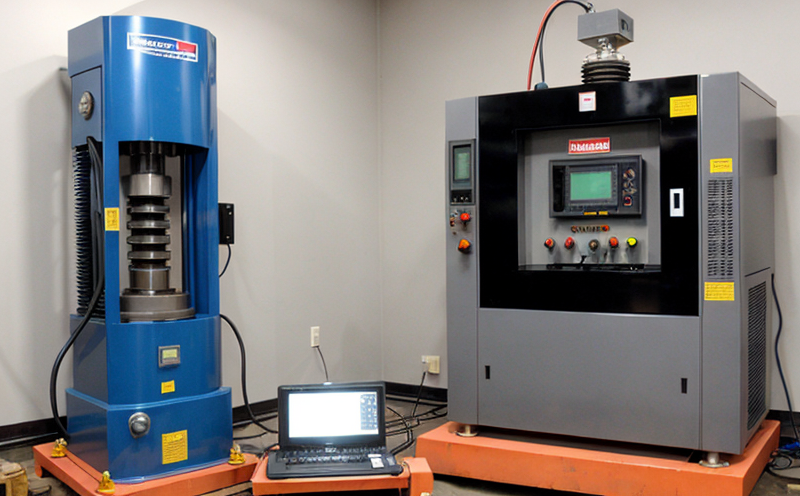EN 60068 2 64 Random Vibration Testing for Electronic Devices
The EN 60068-2-64 standard specifies the procedures and requirements for the determination of the effects of random vibration on electronic devices. This test is crucial in ensuring that electronic products can withstand mechanical shock and vibration encountered during transportation, handling, and use.
Random vibration testing involves subjecting a specimen to a wide range of frequencies with varying amplitudes over time. The goal is to simulate the real-world conditions that an electronic device might experience. This type of testing helps manufacturers identify potential weaknesses in product design or material selection before the product reaches the market.
The test setup typically includes a vibration table, which can generate complex, multi-axis random vibrations with controlled parameters such as frequency range, acceleration peaks, and duration. The specimen is clamped onto the table to ensure it remains stable during testing. Environmental conditions like temperature and humidity may also be controlled based on specific requirements.
The test results are evaluated by observing any changes in the device's performance or structure after exposure to vibration. Acceptance criteria are defined in the standard, specifying thresholds that must not be exceeded for the product to pass the test. If a product fails, it may indicate issues with its design, materials, or assembly.
Random vibration testing is particularly important for electronic devices used in harsh environments such as automotive electronics, aerospace components, and medical instruments. It helps ensure that these products meet regulatory requirements and customer expectations regarding reliability and durability.
In addition to the standard test procedure, there are various optional parameters and configurations available, depending on the specific needs of the product being tested. For instance, different frequency ranges or amplitude levels can be selected based on expected environmental conditions. Understanding these options allows for a more tailored approach to testing, ensuring that the results accurately reflect real-world scenarios.
Random vibration testing is not only about compliance with standards but also about enhancing product quality and reliability. By identifying potential issues early in the development process, manufacturers can improve their products' overall performance and extend their lifespan. This proactive approach can lead to significant cost savings by avoiding costly recalls or replacements after the product has entered the market.
In conclusion, EN 60068-2-64 random vibration testing is a vital tool in the quality assurance process for electronic devices. It provides valuable insights into how products will perform under challenging mechanical conditions, helping manufacturers make informed decisions to improve their offerings.
Why It Matters
The importance of random vibration testing cannot be overstated in the electronics sector. The harsh environments that electronic devices often encounter can lead to premature failure or reduced performance, which can have significant implications for both manufacturers and end-users.
- Ensures Product Reliability: Random vibration testing helps identify potential weaknesses in a product's design, materials, or assembly. By addressing these issues early in the development process, manufacturers can enhance the reliability of their products, reducing the risk of failures in the field.
- Compliance with Standards: Meeting regulatory requirements is essential for market access and customer satisfaction. Random vibration testing ensures that electronic devices comply with relevant international standards such as EN 60068-2-64, which are designed to protect consumer safety and product integrity.
- Reduces Costs: Identifying issues during the testing phase can prevent costly mistakes in later stages of production or after a product has entered the market. By conducting random vibration testing early on, manufacturers can avoid expensive recalls and warranty claims, ultimately saving time and money.
Why Choose This Test
- Comprehensive Simulation: The test simulates the random vibration environments that electronic devices may encounter in real-world scenarios, providing a comprehensive evaluation of product performance.
- Regulatory Compliance: Ensures compliance with international standards such as EN 60068-2-64, helping manufacturers meet regulatory requirements and gain market access.
- Durability Assessment: Identifies potential durability issues before the product reaches the market, ensuring longer-lasting and more reliable products.
- Cost Savings: Early identification of design flaws can prevent costly mistakes in later stages of production or after a product has entered the market.
Competitive Advantage and Market Impact
Random vibration testing offers significant competitive advantages for manufacturers. By ensuring that their products meet stringent quality and reliability standards, companies can differentiate themselves from competitors in the market.
The ability to provide reliable and durable products is a key factor in gaining customer trust and loyalty. This, in turn, can lead to increased sales and market share. Moreover, compliance with international standards enhances the reputation of manufacturers, making it easier to penetrate new markets and regions.
Random vibration testing also supports sustainable business practices by identifying and addressing potential issues early on, reducing waste and minimizing environmental impact. This proactive approach can contribute positively to a company's brand image and long-term success in the industry.





